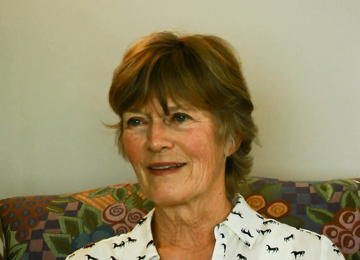Margaret

9 years since diagnosis
Age at interview: 68
Margaret has three grown children and 6 grandchildren and lives on her own. She worked as a home economist and is now retired.
Margaret received her diagnosis in 2006.Margaret noticed a lump in her breast and had it checked by the doctor. A mammogram and ultrasound didn’t show anything and Margaret was relieved. During her annual check-up, a year later, Margaret still had the lump but again nothing was found during more tests. This time the doctor referred her to a surgeon who did a surgical biopsy and she heard the same day that the lump was actually breast cancer. She carried on that weekend with her original plans and spent a weekend with friends, but soon after underwent a lumpectomy and 30 lymph nodes were also removed.
During chemotherapy Margaret tried to take a walk every day except for the days that she was feeling very bad. The biggest hardships for her were the nausea and the pain from the Neulasta injection. Which she needed to boost her white cell count. After chemo Margaret took Arimidex for five years to lower her estrogen and treat her cancer. The first year she had pain in her whole body every single day. But after one year the pain went away. When she stopped taking the Arimidex, she somehow felt a loss as if she was losing some sort of protection. On her request, Margaret has recently started to take Tamoxifen, and she feels it is going well. Margaret developed lymphedema in her right arm and she wore a sleeve and glove for a year; she also received a drainage massage once per week and she saw a physiotherapist at the cancer hospital. She has been very diligent in doing exercises to prevent the lymphedema from returning. Overall, Margaret feels she has received amazing support from her family and friends during her treatment. People still join her on daily walks, and her daughter and a friend used to accompany her to the chemo treatments while others brought her food. Margaret feels that the great support and her daily walks have helped her to remain strong, courageous and positive.
Margaret was able to become an active member of a dragon boat team after her treatments. She loved being part of the team and to share the love, care and support amongst the members. Learning to meditate provided another powerful way for Margaret to cope with treatments; she meditated religiously before chemo sessions. She learned that not everything in life is worth worrying about this helps her to better value the things in life that are important to her.
More content
- Chemotherapy – MargaretOne of the hardest thing for Margaret was the pain caused by the Neulasta injections that she had to give herself.
- Relating to health care professionals – MargaretMargaret notes how important it is to treat each woman as an individual.
- Coping strategies – MargaretMargaret described the benefit she experienced from meditation.
- Follow-up care and the risk of recurrence – MargaretMargaret was uncomfortable about being discharged from care; her cancer had not been detected through imaging and she was worried about it coming back undetected.
- Treatment for lymphedema – MargaretMargaret describes her treatments for lymphedema.